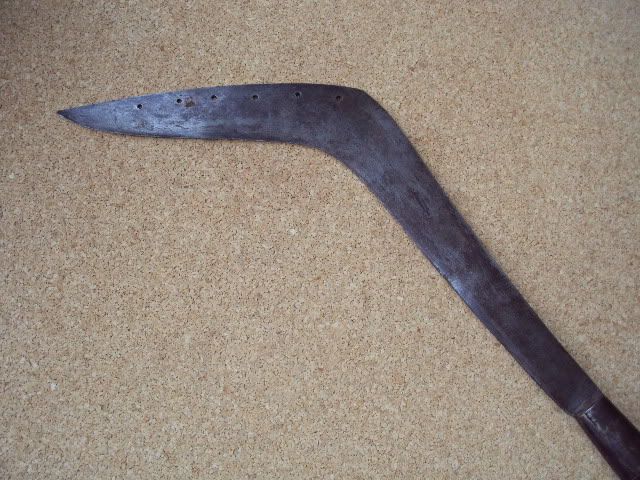
 |
|
|
#1 |
|
Member
Join Date: Dec 2004
Location: Sint-Amandsberg (near Ghent, Belgium)
Posts: 830
|
Just came back from the weekly antiques market in Gent (Belgium)....and I found this sickle knife which intrigues me.
At first sight, it is not the typical African sickle knife as we all know. I'm not even sure it's African   The wooden handle is embellished with copper nails and shows a good patina. The metal blade is sharpened on the inside. Near the handle it's 8 mm thick. It also has 6 holes drilled into the top part. There's also an iron ferrule between the handle and the blade. Total length is 63 cm (from bottom of handle to tip of the blade). Does anyone has an idea ?      |
|
|

|
|
|
#2 |
|
Member
Join Date: Dec 2004
Location: Sint-Amandsberg (near Ghent, Belgium)
Posts: 830
|
No one has a comment ?
 Luc ? 
|
|
|

|
|
|
#3 |
|
Member
Join Date: Jan 2008
Posts: 1,430
|
Unusual piece - I have never seen one like it. The iron round the handle near the blade appears on some small Chokwe knives, and holes in the blade are not uncommon on Congo weapons, as are the brass studs...
Regards. |
|
|

|
|
|
#4 |
|
Member
Join Date: Feb 2006
Location: France
Posts: 472
|
No idea, sorry.
Maybe more a tool than a weapon ? |
|
|

|
|
|
#5 |
|
(deceased)
Join Date: Dec 2004
Location: East Coast USA
Posts: 3,191
|
Freddy
That blade seems quite thick for an African blade even kukri like in appearance? Do you think this was converted from some other knife or tool? Still I like it,very cool 
|
|
|

|
|
|
#6 |
|
Member
Join Date: Dec 2004
Location: netherlands
Posts: 75
|
hi freddy,
it reminds me of a javanese tool for cutting crops, kudi type. should be found in different books on this matter. zonneveld? greets ron |
|
|

|
|
|
#7 | |
|
Member
Join Date: Dec 2004
Posts: 1,247
|
Quote:
Wasn't there a thread back in the mists that talked about old African weapons being thick and fully functional? To me, that handle looks African, but who knows? We're in a global world, and maybe an African artist got inspired by something he saw in a Korean factory... Anyway, I'm not bothered by a thick blade. Best, F |
|
|
|

|
|
|
#8 |
|
(deceased)
Join Date: Dec 2004
Location: East Coast USA
Posts: 3,191
|
Fearn
The hilt seems to be from an old 19th century tool so maybe this was converted into the knife we see here today. Luc also can not place it and he has probably seen them all 
|
|
|

|
|
|
#9 |
|
Member
Join Date: Dec 2004
Location: Sint-Amandsberg (near Ghent, Belgium)
Posts: 830
|
Thanks for the input, guys.
The blade is 8 mm thick near the handle. I've examined this piece this weekend and although the handle looks African, the blade doesn't. It just doesn't feel 'African'. And yeah, the blade is a bit shaped like a kukri....and very sharp. The ferule between the handle and the blade is not new. Judging from the patina, it has been there quite some time. Could be a tool, but could also be a weapon. Why would anyone bother to embellish the handle of his tool with nails ? Weight of this piece is just over 700 grams. |
|
|

|
|
|
#10 |
|
Member
Join Date: Dec 2004
Location: The Netherlands
Posts: 1,209
|
My first feeling was a sickle shaped indonesian weapon. A clurit. I googled on clurit and found clurit with holes in the blade. The piece gives me an oriental feeling.
|
|
|

|
|
|
#11 |
|
Member
Join Date: Dec 2004
Posts: 1,247
|
I guess the thing that bothers me about Indonesia are the copper nails as decoration, and what really looks like a Christian cross (albeit upside-down) on the handle.
Are we going towards a Christian minority piece here? Possibly with Portuguese or other European influence? Best, F |
|
|

|
|
|
#12 | |
|
Keris forum moderator
Join Date: Aug 2006
Location: Nova Scotia
Posts: 7,113
|
Quote:
The blade does look S.E. Asian to me. 
|
|
|
|

|
|
|
#13 |
|
Member
Join Date: Nov 2010
Posts: 129
|
African tools and weapons, e.g. Mangbetu knives, are frequently found in Belgium - many came from the various parts of the former Belgium Congo (in 1960 it became the Democratic Republic of Congo). Many colonialists brought back souveniers of their time there - so it was found in the right place to be of possible African origin.
Many agricultural tools were exported to the colonies, often as bare blades, and handled locally. I recently saw for sale an african sickle - with a german edge tool maker's stamp on the blade - blade german, handle african - what does that make it???? Your tool however, is reminiscent in shape to the Gurka kukhri - many other forms of billhook and sickle exist in Nepal - it is possible yours is a relative of this well known weapon/tool... Ref the decoration on the handle - many tools from Europe and other parts of the world are highly decorated - carved wooden plane bodies, punched marks on billhook blades, ornately turned handles - by comparison the few nails in this handle pale into insignificance... They do not get much more ornate than this presentation french billhook from the 18th century |
|
|

|
 |
|
|